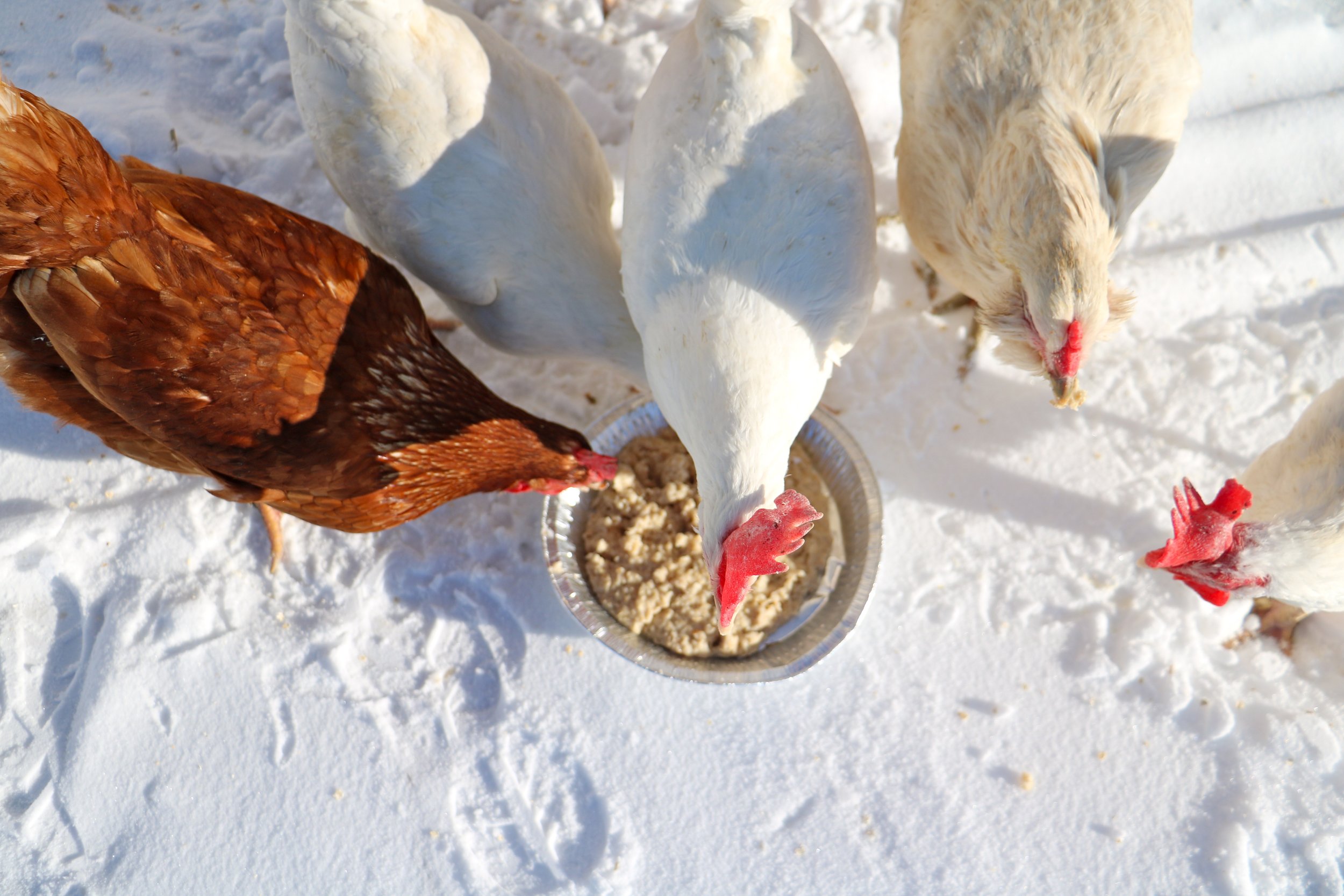Tips for Happy & Healthy Chickens this Winter
Let’s talk chickens and seasonal changes
Chickens, like us, require extra layers to stay warm come early November.
I change out our bedding from summer cotton sheets to my favorite fleece bedding and get out my plaid flannel jammies from storage. Like humans, chickens need some changes during the long cold months. In the hen house, I bulk up the bedding material in the nesting boxes and flooring to our unheated space. A bit of extra insulation goes a long way.
“Chickens need extra calories in the form of scratch corn or cracked grains to supplement their year round diet of poultry feed.”
Our dietary needs change as well. I can tell you here on our homestead, I make a big pot of soup or stew once a week just to keep the chill out of my bones. We live in a very cold, windy and open area in Carleton County and there’s nothing more welcome than homegrown chicken broth and veggies from our root cellar. Chickens need extra calories in the form of scratch corn or cracked grains to supplement their year round diet of poultry feed. Bulking up their feed allows the birds to pack on extra body fat to keep warm. And finally chickens, like people, can get a bit stir crazy after getting use to being able to adventure off in the warmth and beauty of summer and autumn.
Here are 5 tips for keeping chickens in the winter.
1. Maintain Good Coop Ventilation
In your coop; you want to avoid creating stagnant moist air inside during the winter. A build- up of ammonia and moisture from chicken droppings can increase the risk of moldy bedding and respiratory infections. Your coop needs good ventilation and low humidity. You can accomplish this by installing a vent near the top of the coop. On warmer days, I open the back door to the fenced in area and also the main door. I’ll keep it open all day to give it a good air out and give them a chance to get out and about.
2. Winterize your coop
Not everyone has those fancy Pinterest chicken coops. Some are thrown together with lots of airflow, holes and cracks. There are a number of things you can do to keep you feathery friends warm. Plywood, tarp, or plastic sheeting can easily be used to patch holes. Some people depending on the size of their coop can also add bales of hay inside or outside to insulate around the perimeter.
Have you ever heard of the “deep litter method?” it’s when you keep adding layers of fresh bedding on top of soiled bedding that provides insulation and heat! This method needs to be carefully managed and if not, it can increase the level of humidity, which like discussed before… can cause mold and health issues with your chickens.
3. Inside Your Coop
Having the proper roost, nesting boxes, and light inside your coop is important for functionality especially in winter.
Roosts
A chicken roost is a perch to sit or gather on. Your roost should be 1-2 feet above ground and offer easy access to nesting boxes for morning laying. For most average size adult chickens, plan for about 10 inches of bar space per bird. The width of the board should be anywhere from two to two and a half inches of flat surface for perching. A roost provides many benefits like keep chickens off the cold floor, gives them a place to snuggle up to their buddies and fluff out their feathers to help keep each other warm. There is warmth in numbers and that’s why more chickens is better when it comes to keeping them in winter...plus you can never have too many chickens… right?
Nesting boxes
A good rule of thumb is to provide one nesting box per 4-6 hens. The standard nesting box for a regular chicken needs to be a 12 inch cube, 12 inch tall, wide and deep. This will fit the average hen nicely. Hens like fresh material in their nesting boxes and need a little extra during the cold snaps. It’s recommended to be changed 1-2 times a week. The cleaner it is, the less time you’ll need to spend washing off your eggs.
Let There Be Light
Did you know chickens need 12-14 hours of light in order to lay an egg each day? If you’re building a coop from scratch, one of my top suggestions is to incorporate windows in your chicken coop design. Make sure a window is placed on the south side to maximize solar gains. It’s normal for the ladies to slow down egg production in winter because of the shorter days. Other than natural light, we use a solar light that we turn on in the evening inside. Some people won’t agree with this method because it goes against nature but it’s just a tool we use at least a few times a week.
4. Cooped Up Chickens
It’s no secret that chickens don’t care for the snow but there’s many ways you can encourage them to get out on nice sunny days! You can scatter hay or straw on the ground and make a little path for them to adventure out on. Some people go the extra mile and make a cold frame/green house structure covered in plastic that attaches to the chicken door. I personally dig a pathway for my flock so they can exercise outdoors without having to climb snowdrifts, which can damage their feet. This usually requires some bribing with treats and leftovers.
When chickens are cooped up, they can become bored/ stir crazy just like us humans. I usually make 3 trips to feed, water, and collect the eggs during the day. During these check-ins, I’m always doing a quick observation of the chickens and the coop to see if anything is off or needs addressed. I want to be proactive and get ahead of problems, especially when it comes to the chickens picking on each other and the possibility of blood. It doesn’t happen often, but it does happen. If a chicken is bleeding for whatever reason, they should be removed right away. Chickens are very attracted to the colour red and the sight of blood can cause them to keep injuring the already injured bird. One my favorite chickens, Feather, had a cut on the bottom of her foot last week and luckily I caught it early. (Yes, I name some of my chickens). I removed her from the coop, washed her foot in water and poured some hydrogen peroxide on the cut. I then kept her inside out of the cold and in our brooder cage for a few days. She healed up nicely and is back with everyone.
5. Water And food
Water
Like all of us, chickens need water to survive. Your ladies should have water made available at all time. Keeping clean fresh water for any animal in winter can be tricky when it’s likely to freeze. Keeping the water inside and winterizing your coop will help prevent it from freezing. You can insulate the chicken water container, change it manually a few times a day, or if you have electricity available in your chicken coop…you can use a heated poultry water or pet bowl. We change it out manually in the morning, afternoon and before bedtime. We fill up our bowls with warm water instead of cold water. This helps thaw the ice in their water dishes.
Food
Chickens dietary requirements change and so does the volume of food they consume during the winter. Their body moves from a state of production to a state of repair. Chickens need a lot of protein when laying eggs, but during the state of repair in the winter, they will need more carbohydrates to keep themselves warm. Feeding them cracked corn at suppertime is not only a good way to fill them up but it provides them with warmth. As the chickens digest the corn their digestive system gets to work and this produces heat inside the hens body. Scratch grains are also a great alternative.
Did you know that you could also feed them scrambled eggs? Yes, eggs that your chickens laid can be fed back to them. It’s an excellent source of protein and helps them store energy during the winter.
All this requires extra effort on my part, but my chickens deserve it and my family benefits as well.
A Winter Treat!
Winter oatmeal immune boost
Cook 1-cup oatmeal and then mix in some spices:
A dash of cayenne pepper to help warm them up
A dash of garlic powder & oregano for their immune system
Once cooked, I let the oatmeal cool down slightly before feeding it to them.
If you and your family are doing winter chicken chores or try this recipe, tag us @cummingsbenj on Instagram and share what connects us all on our homesteads from far and wide!





